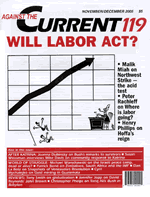Against the Current, No. 119, November/December 2005
-
From 9/11 to Katrina
— The Editors - After Katrina
-
Bush to New Orleans Survivors: "You're On Your Own"
— Joanna Dubinsky -
Surviving When the State Disappeared: Community vs. Katrina
— Suzi Weissman interviews Mike Davis - Labor Under Attack
-
The Northwest Strike: Acid Test for Labor
— Malik Miah -
The Northwest Airlines Strike: Where is Labor Going?
— Peter Rachleff -
Hoffa Jr.: The Real Record
— Henry Phillips - World of Struggle
-
Zimbabwe: Mbeki to Mugabe's Rescue
— Patrick Bond -
A Commentary from Israel: Peace Camp - Dead or Alive?
— Michael Warschawski -
Indigenous Resistance to Gold Mine Gains Momentum
— Cyril Mychalejko -
Snapshots of the Bolivarian Revolution
— Dan La Botz - Celebrating the Revolutionary Centenary
-
From 1905 to Our Time
— Sheila Cohen - Reviews
-
John Brown, Abolitionist
— Jennifer Jopp -
Background to Bush's Debacle: Iraq and the Empire
— Christopher Phelps -
Globalization's Damages
— Tony Smith - In Memoriam
-
Little Milton and Clarence Brown
— George Fish
Cyril Mychalejko
LAST JUNE 13 indigenous communities in Sipacapa, in the western highlands of Guatemala, voted overwhelmingly to reject gold mining on their lands. Oxfam’s press release announced the results: 2,486 people cast their vote against the mine, 35 voted in favor, 32 abstained and one cast a blank vote.
The Canadian/U.S. mining company, Glamis Gold is constructing a World Bank funded open-pit mine in near-by San Miguel. With construction nearly complete, the company is eager to begin drilling. But local community members fear contamination of their water supply, an important resource for the area’s large farming community.
In an interview with Business News Americas, Glamis’ Senior Vice President Charles Jeannes responded to the vote by saying, “The private interests went ahead and held something — I don’t know what you call it — a referendum or non-binding, non-sanctioned vote if you will.” He insisted that the mine remains popular and “the majority of the residents in the vicinity of the mine support our activity.”
The Guatemalan government has used violence to protect Glamis’ interests. Last January the military killed a protestor and injured dozens of others. Once the indigenous communities in Sipacapa organized a process of consultation, Guatemala’s Ministry of Mines and Glamis attempted to stop the voting. In fact, the Supreme Court ruled against the communities’ election. The company claims the whole process of consultation is illegal, unconstitutional and “corrupt.”
And if this level of intimidation wasn’t enough, Glamis and the government placed responsibility for orchestrating opposition on a few individuals and on non-governmental organizations including Rights Action, a community development organization based in Canada, with an office in Guatemala City.
Seventy-five national and international observers disagree with Jeannes’ assessment. In a communiqué they reported that the consultations “unfolded normally in all of the communities, according to traditional indigenous customs…[and that local residents] freely and democratically participated in the consultation process, expressing their decisions regarding mining activity.”
Truth and Consequences
The consultations in Sipacapa dealt a thunderous blow to Glamis’ project, even though opposition to the mine is not unanimous. This is especially the case in the divided community of San Miguel, where some residents have been employed by the company. But all signs point to changing tides. As Marcelo Etequiel Lopez, a resident of Tres Crues, Sipacapa summed up the struggle, “Thank God we have figured out what’s going on. Now we are going to defend our rights.”
Recently, many of the claims made by local residents of malfeasance (if not criminal activity) on the part of Glamis and the World Bank were validated — by the World Bank. The Financial Times received a draft copy of the World Bank’s Compliance Adviser Ombudsman’s response to a formal complaint filed by the Guatemalan NGO Madre Selva regarding the mining project. The FT reported that the Ombudsman “charges that the bank failed adequately to consult the local community or properly evaluate the environmental and humanitarian impact of the mine.”
The article even mentions the results of Sipacapa’s “illegal” referendum in which 98% of the residents rejected mining.
It’s Not Over Yet
For those fighting Glamis, the World Bank report is a positive step. A source within the World Bank apparently thought the report, which according to news reports was supposed to be confidential, should be released. However, many have expressed concerns with the World Bank’s oversight procedures, saying that it is dangerous to rely on international law (such as ILO covenant 169) because there are no tangible enforcement mechanisms.
Grahame Russell, co-director of Rights Action, pointed out that “Impunity is the norm in how the global community works.”
However, the conditions in Guatemala point to the possibility of an exception to this rule. Indigenous communities in Sipacapa continue to meet on a regular basis in their organizing efforts against the mine, and San Miguel is readying itself for its own referendum.
Most opponents of the mining project expect Glamis to continue its lies and repressive tactics, with the support of the Canadian government.
In the meantime, the international, U.S. and Canadian press still has not found the story of the World Bank and a multinational mining company violating international law and the rights of indigenous Guatemalans to be sufficiently newsworthy to merit thorough coverage.
But despite these obstacles, community members, along with a growing supporting network of activists, solidarity groups and NGOs, believe that the mine can be shut down.
ATC 119, November-December 2005

